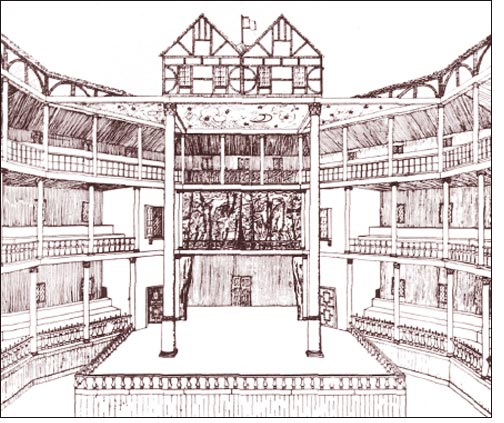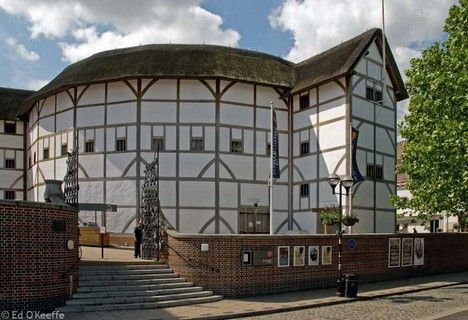The Original Globe Theatre Burns Down
-
29th June 1613
In 1597 a certain Mr Allen failed to renew the lease on the land on which the theatre owned by Richard Burbage, the leading actor in a company named ‘The Lord Chamberlain’s Men’, was built. A clause in the lease stated that anything built on the land belonged to Burbage and so when Allen was away over Christmas of that year the theatre was taken down and the timber stored in his yard that he shared with a builder – Peter Streete.
Burbage could not afford to lease a new plot of land and thus offered joint ownership of the company to five other members – including William Shakespeare – for £10. With the money raised from this sale they were able to acquire land just outside the city on the South Bank in Southwark near to the Rose Theatre. The fact that it was just outside the City had the advantage of being free from the authorities, who were not keen on theatres at all.
 Come the spring Peter Streete transported the timber across the river Thames and re-built it. It is thought that the first play performed there was Julius Caesar in 1599 and it was a huge success. Other notable plays premiered there were Hamlet, King Lear, Macbeth, As You Like It and Othello. Ben Johnson was also to write plays for the Globe.
Come the spring Peter Streete transported the timber across the river Thames and re-built it. It is thought that the first play performed there was Julius Caesar in 1599 and it was a huge success. Other notable plays premiered there were Hamlet, King Lear, Macbeth, As You Like It and Othello. Ben Johnson was also to write plays for the Globe.
Seating up to 3000 in three stories of seating that were covered there was also an area called the pit – open to the elements. The people here were called ‘Groundlings’ and paid 1 penny. In the summer they were nicknamed ‘Stinkards’ for obvious reasons. The walls of the theatre were made from timber frames that were filled in with smaller slats of wood – like a medieval wattle and daub house – then plastered with mud with cow hair in to hold it together. As funds were low costs were kept to a minimum and instead of using tiles they used reeds for a thatch roof.
Outside the theatre plays were advertised by using a coloured flag. A red flag was used for history plays, a white one for comedies and a black one for tragedies. Above the entrance the words ‘Totus Mundus Agit Histrionem’ were written. This translates as the whole world is a playhouse. At the start of each performance collectors took a box around to collect the admission fees. When they were filled they were taken to a back room off the stage that became known as the ‘Box Office’. Then a trumpet sounded the start of the performance.
On the 29th June 1613 there was a performance of Henry VIII. Cannons were used for the effects. No cannon balls were required just gunpowder and wadding. Unfortunately some of the wadding landed in the reeds of the thatched roof and within one hour the theatre had be burned to the ground. No one was injured other than a gentleman whose breeches caught alight. A bystander using his bottle of beer put these out.
A second Globe was re-built and opened the following year. This time they used tiles and the whole building was more ornate as funds were more readily available. However in 1642 it was closed by the Puritans, who were vehemently against all stage plays, and the theatre was turned into tenement housing.  It was not until 1970 when Sam Wanamaker, the American actor and director, set up the Globe Trust to rebuild the theatre, and it rose for a third time. He had been performing Shakespeare in Cleveland, Ohio, and wanted to recreate the original as closely as possible. It took 23 years to get planning permission, funds and find the land. 1000 English oak trees were used to build it using the same techniques and tools that built the original. They also used 6,000 bundles of Norfolk reeds to make the thatch roof. This needed special permission as no house or building had been allowed to be thatched, by law, after the Great Fire of London in 1666.
It was not until 1970 when Sam Wanamaker, the American actor and director, set up the Globe Trust to rebuild the theatre, and it rose for a third time. He had been performing Shakespeare in Cleveland, Ohio, and wanted to recreate the original as closely as possible. It took 23 years to get planning permission, funds and find the land. 1000 English oak trees were used to build it using the same techniques and tools that built the original. They also used 6,000 bundles of Norfolk reeds to make the thatch roof. This needed special permission as no house or building had been allowed to be thatched, by law, after the Great Fire of London in 1666.
The original was thought to be round but when the foundations were explored more carefully in the 1980s it was found to be a polygon of 20 sides. The 3rd Globe is as near as they could get it, geographically to the original – just one street nearer the river. The first performance was in 1993 whilst it was still being built. Unfortunately Mr Wanamaker never saw its completion in 1997, as he had died 4 years earlier. Today the Globe attracts hundreds of thousands of people from around the world as well as running many educational programmes and is one of the great success stories of modern theatre.


